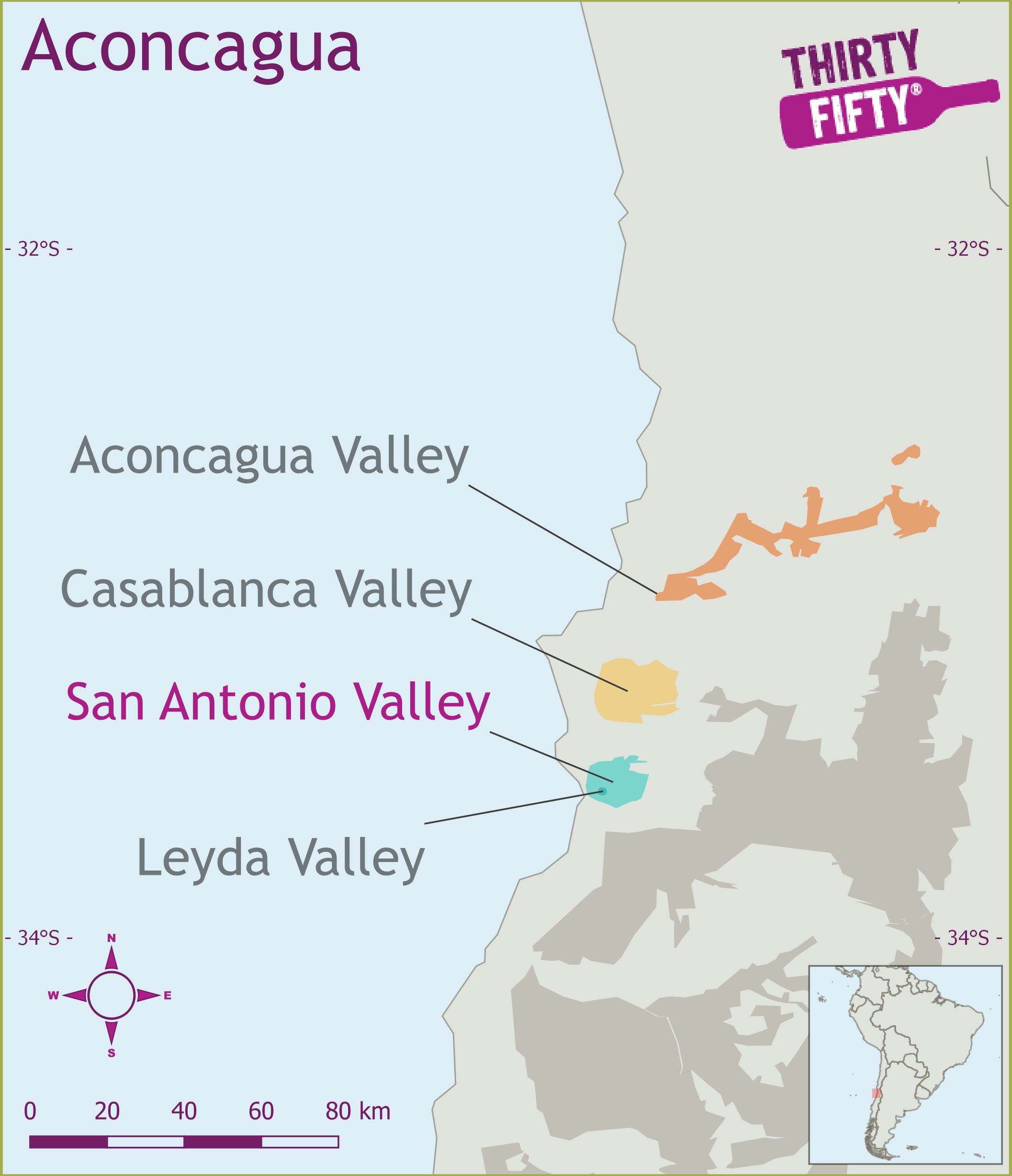San Antonio Valley's Climate: Warm Maritime
Warm Maritime
San Antonio Valley's Grapes: Chardonnay, Pinot Noir, Sauvignon Blanc
Chardonnay
Jancis Robinson described Chardonnay as the tart of the grape world, as it would lie down anywhere and do what the winemaker told it to do! In other words it will grow almost anywhere and produce decent and quite stylistically different wines ranging from minerally Chablis, Champagne, buttery fruit wines, tropical fruit wines or oaky vanilla wines. During the late 1990's Chardonnay was the drink of choice for many. However people became bored with the oaky wines found in so many bars and the term, 'ABC' (Anything but Chardonnay) came about. The ubiquitous yet noble Chardonnay grape has virtually become a brand name. From its homeland in Burgundy, its fame and fortune have taken it all over the world. It�s grown on different soils in varying climates to be used either as a single varietal or in blends, for still and sparkling wines, and with or without oak ageing to create a wide range of wines with diverse personalities. As a result, it�s impossible to describe a typical Chardonnay. For a start, the grape can make anything from an everyday glugger to a high-quality wine deserved of ageing. Its popularity in the vineyard stems from the fact that it�s easy to grow, consistently yielding generously with relatively high sugars (and, therefore, alcohol). In the winery its advantages are obvious � it�s difficult to make a poor wine from it, unless it�s been picked too late, because then its acid levels fall quickly, which make it flabby. Chardonnay isn�t strongly aromatic: some detect anything from apples (or barely ripe apples in Chablis) and melon in Maconnais Chardonnay to tropical fruit flavours in New World examples. Common descriptives, however, tend to refer to texture and weight rather than flavour � buttery for broader styles, such as Meursault from the Cote de Beaune; steely for Montrachets and nutty for Corton-Charlemagne. There�s an attractive leanness to fine Cote d�Or white burgundy, that sets it apart from Chardonnays from the rest of the world, but this can be emulated further south in the Cote Chalonnaise and Maconnais in good vintages with clever winemaking.
Pinot Noir
Pinot Noir (pronounced PEA-no NWAHR, the grape that produces Burgundy's finest red wines, is one of the hardest to grow. This thin-skinned variety is generally an early budder and ripener, so it is best-suited to cool, marginal climates - 40 to 50 degrees latitude - and only produces good wine when the fruit is controlled to very low yields. It has the problem that it mutates easily and is also particularly susceptible to leaf roll, and to rot because of its compact grape bunches. Pinot has no single recognisable flavour or style. Young Burgundy, however, can be reminiscent of raspberries or strawberries, while mature French Pinot tends to evolve into anything from violets, game and truffle to farmyard aromas and compost. Despite its difficult temperament, Pinot Noir is hardly just a French phenomenon. It crops up in Northern Italy, Germany, Switzerland and Eastern Europe as well as California, Australia, New Zealand and even South Africa and Chile. It�s a successful ingredient for sparkling wine and is one of three grapes used in champagne, bringing good acidity, structure and body. Pinot Noir goes by a long list of names, which include Spatburgunder and Blauburgunder in Germany and Klevner in Switzerland.
Sauvignon Blanc
Grassy and herbaceous, with the characteristics of gooseberries, nettles and cat�s pee � this can only be referring to one grape variety: Sauvignon Blanc. The grape has its origins in Bordeaux but is now widely cultivated over France and around much of the world. Think of Pouilly-Fume and Sancerre from the Loire � both these wines are made from Sauvignon Blanc and are, probably, the grape in its purest form: crisp, dry, aromatic and unoaked. In Bordeaux, it�s blended, particularly with Semillon, for the dry whites there, but it�s also an ingredient for the region�s luscious dessert wines, such as those of Sauternes and Barsac. On the other side of the world, however, New Zealand has also virtually made this white variety its own, giving the wine a screwcap along the way. Yet this fashionable grape does have its faults. For one, unblended, it doesn�t age. Wines made from Sauvignon Blanc are generally meant to be drunk young, but then that can also be a bonus � as soon as you�ve bought a bottle, you can just chill this zesty little number and enjoy it! On the growing front, it�s susceptible to botrytis, oidium and black rot and will also rot if grown on fertile soils, preferring gravelly or sandy loams, or chalk in parts of the Loire. It also tends to be very vigorous and if it�s allowed to become over-productive on heavy soils, then the characteristics of the wines will be much diluted. Sauvignon Blanc goes by a few other names, the most common probably being Fume Blanc, as it�s known in California.


